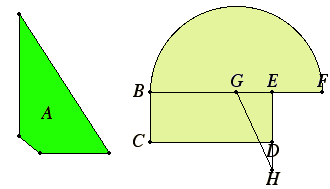Proposition 14
To construct a square equal to a given rectilinear figure.
Let A be the given rectilinear figure.
It is required to construct a square equal to the rectilinear figure A.
Construct the rectangular parallelogram BD equal to the rectilinear figure A.
Then, if BE equals ED, then that which was proposed is done, for a square BD has been constructed equal to the rectilinear figure A.
But, if not, one of the straight lines BE or ED is greater.
Let BE be greater, and produce it to F. Make EF equal to ED, and bisect BF at G.
Describe the semicircle BHF with center G and radius one of the straight lines GB or GF. Produce DE to H, and join GH.
Then, since the straight line BF has been cut into equal segments at G and into unequal segments at E, the rectangle BE by EF together with the square on EG equals the square on GF.
But GF equals GH, therefore the rectangle BE by EF together with the square on GE equals the square on GH.
But the sum of the squares on HE and EG equals the square on GH, therefore the rectangle BE by EF together with the square on GE equals the sum of the squares on HE and EG.
Subtract the square on GE from each. Therefore the remaining rectangle BE by EF equals the square on EH.
But the rectangle BE by EF is BD, for EF equals ED, therefore the parallelogram BD equals the square on HE.
And BD equals the rectilinear figure A.
Therefore the rectilinear figure A also equals the square which can be described on EH.
Therefore a square, namely that which can be described on EH, has been constructed equal to the given rectilinear figure A.
Q.E.F.
Guide
The construction of a square equal to a given rectilinear figure is short as described in the proof. The verification that this construction works is also short with the help of Proposition II.5 and Proposition I.47, the Pythagorean theorem. First, Prop. II.5 allows us to convert the rectangle, BE by ED, into the difference of two squares, GF2 – GE2. Note that GF equals GH, the hypotenuse of a right triangle GHE. Using I.47 we can replace the difference of two squares, GH2 – GE2, by the single square, EH2. Thus, the original rectangle equals the square EH2.
Quadrature of rectilinear figures
This proposition finishes the quadrature of rectilinear figures. The narrow meaning of the word “quadrature” is to find a square with the same area of a given figure, also called “squaring” the figure. In a broader sense, quadrature means finding the area of a given figure.
Proposition I.45 on application of areas of rectilinear figures allows us to replace the figure under question with a rectangle of the same area. Now, the semicircle construction in this proposition finds what is called the mean proportional between the sides of the rectangle. If the sides of the rectangle are denoted a and b, then the mean proportional x between them satisfies the proportion a : x = x : b, and that’s equivalent to an equality of areas ab = x2, that is to say, the square on this mean proportional has the same area as the rectangle. Thus, any rectilinear figure can be squared.
This result is an end in itself. It is not used in the rest of the Elements.
There is another proof of this proposition that is based on similar triangles. Referring to the figure in the proposition, draw lines BH and BF, and you’ll see three similar right triangles: BFH, BHE, and HGE. From their similarity it follows that BE : EH = EH : EF. That says EH is the required mean proportional.
Proportions aren’t developed until Book V, and similar triangles aren’t mentioned until Book VI. So in order to complete the theory of quadrature of rectilinear figures early in the Elements, Euclid chose a different proof that doesn’t depend on similar triangles. Note that this same result appears in the garb of proportions in Proposition VI.13. Also in Book VI, Proposition VI.17 shows that the square on the mean proportional equals the rectangle on the two straight lines.
Squaring the circle
What about circles and other shapes? The general theory of circles is treated in Book III, but there are no propositions about the areas of circles until book XII. Proposition XII.2 says the areas of circles are proportional to the squares on their diameters. That allows the area of two circles to be compared, but it doesn’t answer the question “what’s the area of this circle?” in the same way that this proposition does for rectilinear figures. That would require finding a square equal to a given circle.
This problem of quadrature of the circle was one of three famous problems that goes back at least to the time of Anaxagoras, about 150 years before Euclid. It is equivalent to constructing a line segment of length π (relative to a unit length). This problem was solved by ancient Greek geometers but not by means of the Euclidean tools of straightedge and compass; higher curves were required. In fact, by the time of Pappus it was believed that the circle could not be squared using only straightedge, compass, and, furthermore, couldn’t be squared even with the help of the conic sections (parabola, hyperbola, and ellipse). But the ancient Greeks had no mathematical proof that it could not be squared.
That the circle could not be squared with Euclidean tools was not shown until 1882 when Lindemann proved that π is a transcendental number.
